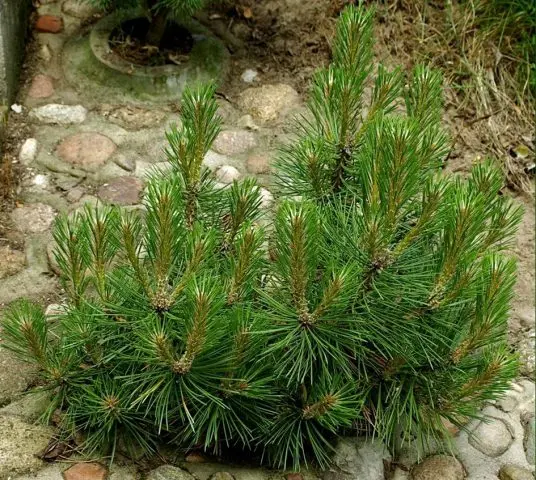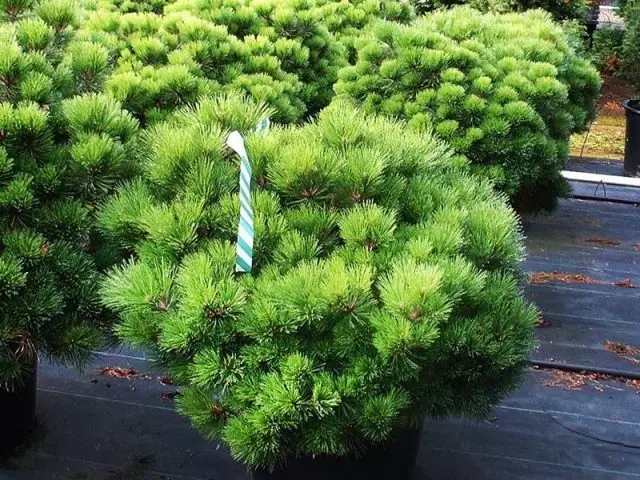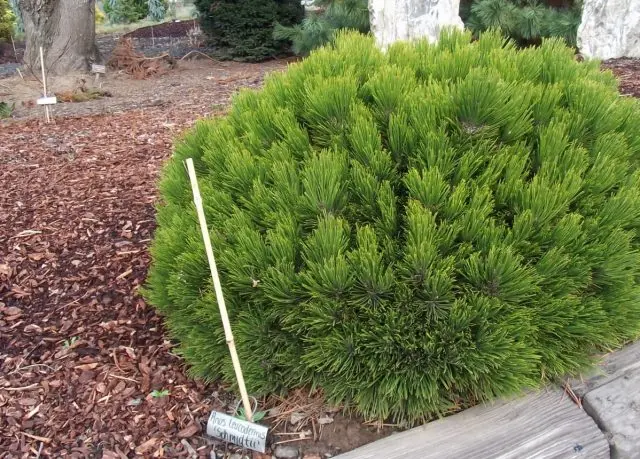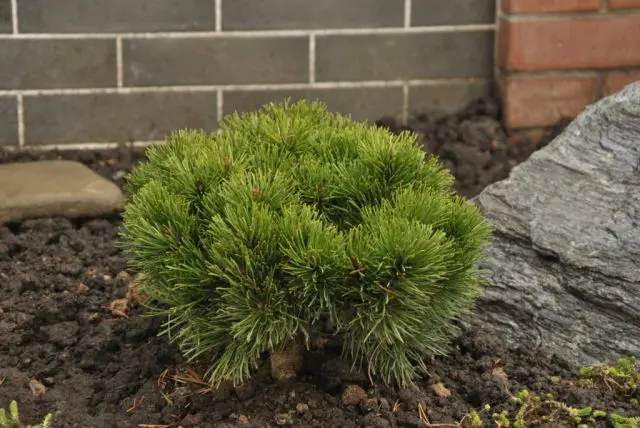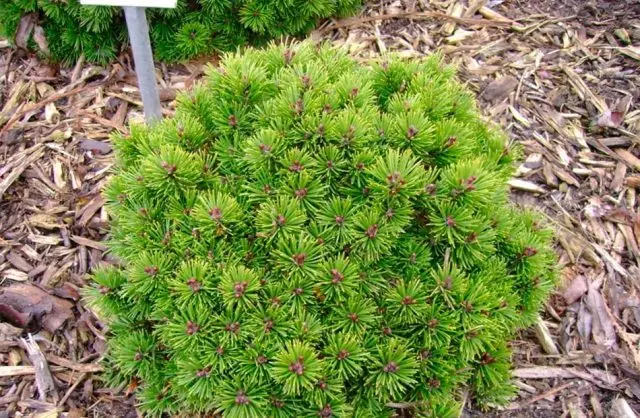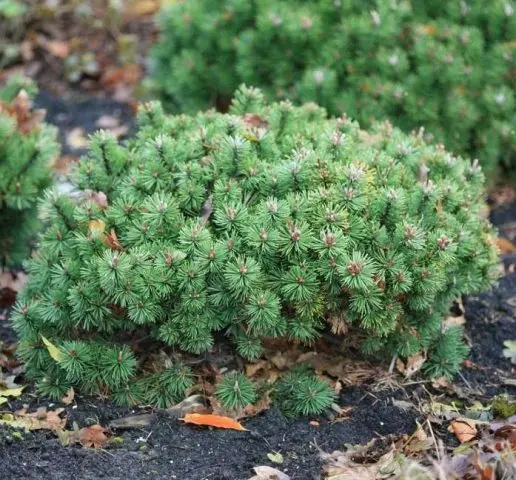Contents
Dwarf pine is a great option for small gardens where large trees are not available. The plant is unpretentious, slowly grows shoots, does not require special care.
Features of growing dwarf pines
Dwarf pine is an evergreen conifer rich in resin. The crown is pin-shaped or creeping, with numerous trunks. Shoots elongated or shortened, covered with needles. The needles are arranged in bundles. Cones – hanging or erect, vary in shape and color.
Dwarf pine develops slowly. The annual growth is from 3 to 15 cm per year. In height, such plants reach no more than 30 – 50 cm.
Most hybrids are obtained by processing planting material, which has led to gene mutation. There are also natural dwarfs. Their compact size helped them to adapt to climatic conditions. This includes varieties of mountain pine.
Growing dwarf pine has a number of features:
- plants are compact and occupy a minimum of free space;
- sensitive to lack of light and moisture;
- may suffer from sunburn;
- suitable for growing in containers;
- tolerate winters well;
- susceptible to fungal diseases.
Dwarf pines in landscape design
Dwarf varieties have found their place in landscape design. They are used to decorate rockeries, rocky gardens and alpine slides. Low-growing plants are suitable for covering slopes and slopes.
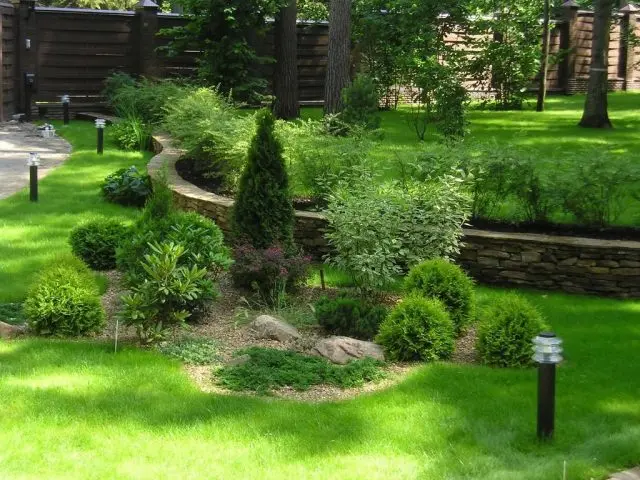
Conifers make a good alternative to a lawn. Dwarf hybrids are located next to perennials, shrubs and trees. The plant is placed in the center of the composition or as an addition to it.
With the help of conifers create mixborders and borders. In this way, paths, space next to fences and buildings are designed. When planting, take into account that the pine grows over time. Seedlings are placed in such a way that they do not interfere with each other.
Types of dwarf pines
Popular varieties of dwarf pine:
- Nana (Nana). Black pine representative. The shrub is compact, up to 1,5 m high. The annual growth is 5 cm. The trunk is dark brown, with strong shoots. The crown is spherical. The needles are hard, dark green. Cones are brown-yellow, grow up to 5 cm. Nana variety requires moderate watering and even tolerates arctic frosts.

- Jane Kluis. Dwarf shrub with a cushion-shaped crown. Refers to a densely flowered species. It reaches a height of 1,2 m, a diameter of 1,8 m. It grows slowly, in 10 years it reaches 0,8 m. The shoots are rigid, directed upwards. The needles are light green, do not change color during the year. The plant is provided with good drainage and natural light. The shrub tolerates winter frosts down to -30 ° C.

- Schmidti. Evergreen pine in the form of a neat shrub. Representative of the white species. The crown consists of numerous shoots directed upwards and arranged very densely. The bark is hard, light in color. The needles are long, emerald green. Shrub up to 0,5 m high, grows up to 1 m wide. Growth – no more than 3 cm per year. The winter hardiness of this dwarf pine is up to -30 °C.
Important! Variety Schmidti prefers fresh drained soils, does not tolerate stagnant moisture.

- Gnome. Mountain pine of the Gnome variety is a small tree or shrub. The crown is dense and neat, spherical. Annual growth – no more than 10 cm. It reaches a height of 2 m, grows up to 2 m in width. The needles are short, dark green. Cones rounded, solitary. The variety of dwarf pine Gnome grows on any soil, resistant to frost and urban conditions.

- Pug (Mops). Dwarf hybrid of mountain pine. The tree is not more than 1,5 m wide and not more than 5 m high. The shoots are short, the needles are straight, dark green, up to 45 cm long. The Pug variety branches well and forms a rounded crown. The hybrid is resistant to drought, prefers sunny areas. Winter hardiness is increased, up to -XNUMX ° С.

- Ofir (Ophir). Miniature pine up to 0,5 m high and not more than 1 m wide. Abundant small shoots form a spherical crown. It grows by 5 cm annually. The needles are prickly and short, slightly twisted. In summer, the color is bright green, by winter it becomes lemon-orange. Cones are small, round, brown. This variety of dwarf pine prefers open areas and tolerates drought well. Winter hardiness – up to -30 ° С.

- Humpy. Dwarf shrub up to 50 cm high and 100 cm wide. Shoots form a small dense mound. The needles are short and yellow, dark green in summer. In winter, the needles turn brown-red. This dwarf pine grows slowly, up to 4 cm per year. The frost resistance of the shrub is high, up to -30 ° С. It does not tolerate saline and marshy soils.

How to grow dwarf pine from seed
For propagation of dwarf pine, ripe fresh seeds are taken. Cones are harvested in October-November. It is best to remove them from the tree, and not pick them up from the ground. The buds are kept warm so that they dry faster. The resulting seeds are left in a cool place.
2 months before planting, the planting material is lowered into the water. If the seeds are on the surface, they are discarded. The remaining specimens are placed in a solution of potassium permanganate for 30 minutes, then washed and kept in water for a day. The swollen seeds are mixed with moistened sand and placed in a refrigerator for 30-40 days.
In April, the seeds are planted with soil containers, a layer of sawdust 2 cm thick is poured on top. The containers are covered with foil and kept warm. Seeds can take a long time to germinate. When the seedlings get stronger, they are transplanted into a substrate for conifers.
Dwarf pine is looked after at home: moderately watered, fed with mineral complexes. Plants are transferred to an open place after 2 to 3 years. Plantings are fed with rotted manure, watered, loosened the soil.
Planting and caring for dwarf pine
The successful cultivation of dwarf conifers largely depends on the landing site. During the growing season, plants are constantly looked after. In the fall, preparations for winter begin.
Seedling and planting preparation
For planting choose seedlings at the age of 3 – 5 years with a closed root system. It is best to choose plants from a local nursery. Select specimens without damage, mold and other defects. Before planting, the roots of the seedling are dipped in water for 3 hours.
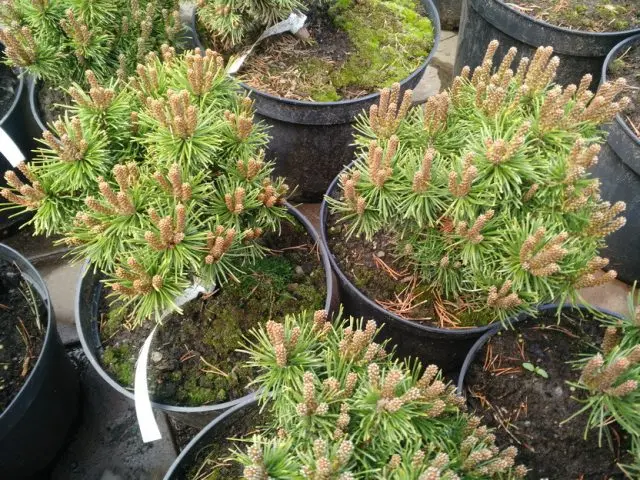
Dwarf pine grows on sandy and loamy soils. When growing in clay soil, a drainage layer is required. It is best to choose a lighted area with moderate moisture for plants. The soil is dug up in the fall, cleaned of weeds and other plant residues.
Rules of landing
The procedure for planting a dwarf pine:
- A hole is being dug in the area. Its dimensions depend on the size of the seedling.
- To fill the pit, a substrate is prepared, consisting of soddy soil and sand in a ratio of 2: 1.
- A drainage layer 20 cm thick of fine gravel or expanded clay is poured at the bottom.
- The pit is half covered with substrate, watered and left to shrink.
- After 2 – 3 weeks in the center of the pit, a small hill is formed from the remaining soil.
- The seedling is placed on top, the root neck should be at ground level.
- Soil is poured over the roots, compacted and watered.
Watering and top dressing
Moderate watering is sufficient for dwarf pine. Its roots are not able to penetrate deep and extract water from deep layers of soil. Excess moisture is also detrimental to the plant. Pine is watered in drought with warm water. Choose morning or evening.
To feed dwarf hybrids, mineral complexes for conifers are used: Pokon, Forte, Compo, etc. Substances are applied in dry form or dissolved in water. For the season, 1 – 2 dressings are enough. Use fresh manure and other fertilizers containing nitrogen with caution.
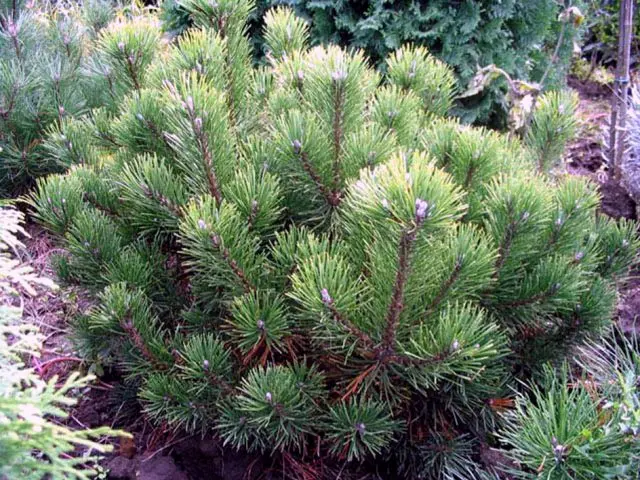
Mulching and loosening
To prevent moisture from evaporating from the soil, mulching is performed. Use humus or crushed bark. It is useful for pine to loosen the soil when a crust begins to form on the surface. When loosening, they try not to damage the roots, which are located in the upper soil layer.
Trimming
Healthy trees do not require annual pruning. Only damaged or dry branches are subject to removal. The crown is cut to give it the desired shape. Processing is stressful for conifers. Therefore, the shoots are shortened by no more than 1/3 of the annual growth.
The best period for pruning dwarf pine is from late February to March. To reduce the growth rate, young shoots are pinched in May-June. As a result, the crown branches better and takes on a compact appearance.
Preparation for winter
Most dwarf hybrids are resistant to winter frosts. In order for the plants to better endure the cold, preparation begins in late autumn. First, the soil is watered abundantly. Under each conifer bring 1 – 2 buckets of water.
Then the trunk circle is mulched with humus or pieces of bark. The second option is preferable because it does not delay the penetration of oxygen into the soil. At the same time, moisture lingers in the soil longer.
Snowfalls lead to breakage of pine shoots. In winter, the branches of coniferous trees are very fragile. Snow is brushed off. If an ice crust appears on the shoots, a support is placed under them. The easiest way is to build a frame from wooden planks or boxes.
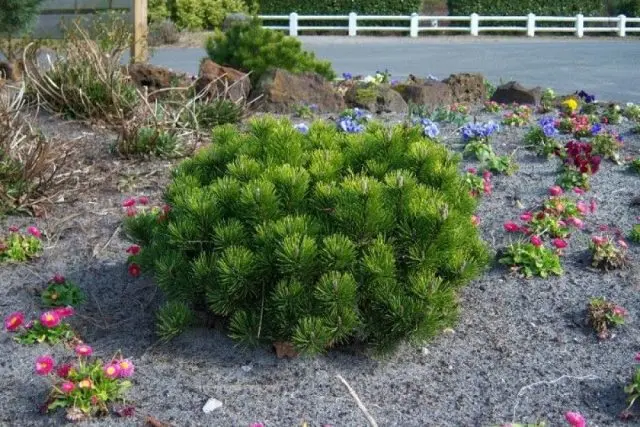
Diseases and pests
The cause of the disease of dwarf pine is often improper care. If the wrong place is chosen during planting or the norms of watering are not observed, then the plant turns yellow, loses its decorative appearance or dies.
With a lack of light and high humidity, pines suffer from fungal diseases:
- Rust. Orange bubbles appear at the bottom of the crown. Anti-rust preparations containing copper are used.
- Resin crab. The lesion has the appearance of yellow or orange lesions. If you do not start treatment on time, the plant will die. It is important to clean the wound and treat it with a solution of copper sulfate. Top put garden var.
- umbrella disease. The first sign of the disease is the death of the apical kidney. To stop the defeat, diseased and dead shoots are regularly removed.
Dwarf pine attracts aphids, sawflies, spider mites, moths and other pests. Against them, insecticides Actellik, Lepidocide, Inta-Vir are used. The preparations are diluted with water in the concentration indicated on the package. Plantings are sprayed during the growing season.
gardening tips
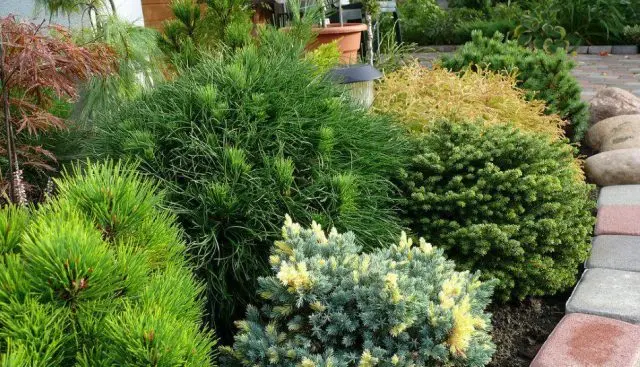
Conclusion
Dwarf pine grows without problems in different climatic zones. The plant will decorate alpine slides and small gardens. Pine care comes down to watering, fertilizing and shelter for the winter. If you choose the right place for planting, the tree will please the eye for several decades.










